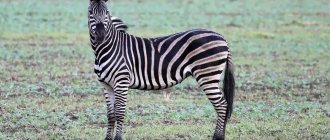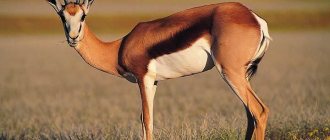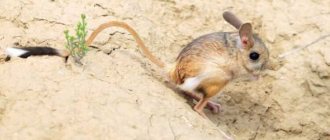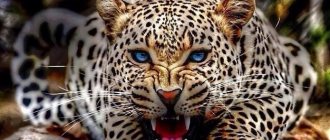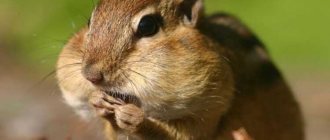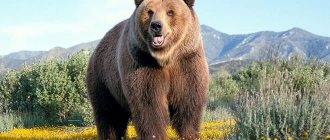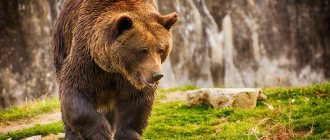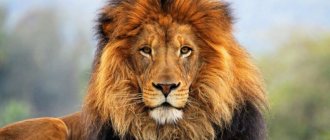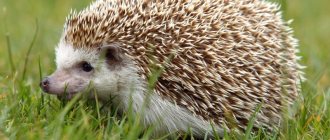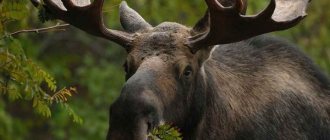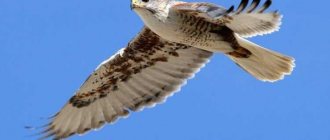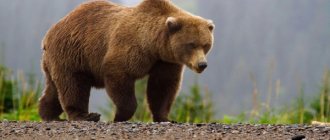- Wild animals
- >>
- Mammals
The brown bear is considered one of the largest mammals on earth. Outwardly, he appears to be an overweight, clumsy and clumsy beast. However, it is not. The mammal is rightfully considered the owner of the dense taiga terrain. The power and greatness of the forest dweller amazes and amazes. Only one more predator of the bear family can compare with it in size - the white polar bear.
Origin of the species and description
According to scientists and archaeologists, bears descended from ancient martens about 3-4 million years ago. The remains of such an ancient species were discovered on the territory of modern France. It was a small Malayan bear. This species evolved into a larger predatory beast - the Etruscan bear. Its territory extended to Europe and China. Presumably this species became the founder of large, black bears. About 1.8-2 million years ago, cave predators of the bear family appeared. It was from them that brown and polar bears originated, which later divided into many subspecies.
Does a bear have a tail?
Scientists have found that millions of years ago, bears had tails. However, the animal did not use this limb in any way. While most animals use it for control while running, for orientation in space and communication, the predator focused on developing the sense of smell and physical strength. As a result, the bear's tail gradually began to decrease until it disappeared completely.
Nowadays, almost all rear views have a regular leather flap that is no more than four inches in length. Bears cannot move it, and this semblance of a tail just dangles from behind.
Appearance and features
The appearance of the predator is striking in its size and power. The weight of one adult individual reaches 300-500 kilograms, the body length is up to two meters. The largest representative of this species lives in the zoo of the capital of Germany. Its weight is 775 kilograms. Males are always larger and are approximately twice as large as females. The body has a barrel-shaped body and massive withers. Powerful, well-developed limbs have five fingers and huge claws up to 15 cm long. There is a small round tail, the size of which does not exceed two tens of centimeters. The large head with a wide frontal part has an elongated nose, small eyes and ears.
The thickness and color of the coat depends on the region where it lives. Bears molt in the summer. During the cold season, as well as during mating periods, bears are especially aggressive. Predators spend almost half the year sleeping. They climb into the den and curl up into a ball. The hind limbs are pressed to the stomach, the front limbs are covering the muzzle.
Natural habitats
Spectacled bears are considered the only animals of the Bear family that prefer to live within South America. Their natural habitats extend to mountain forests in countries such as Venezuela and Ecuador, Colombia and Peru, Bolivia and Panama. Brown bears are more characterized by habitat conditions associated with the basins of rivers such as the Lena, Kolyma, Anadyr, as well as with Eastern Siberia and the Stanovoy Range. They can be found in northern Mongolia, in some regions of China, as well as in the border areas of eastern Kazakhstan.
Typical natural habitats for grizzly bears are western Canada and Alaska. A small number remains in continental America, more precisely in the state of Montana and northwestern Washington. For their life activities, Tien Shan brown bears preferred the Tien Shan mountain ranges and the Dzungarian Alatau, which is connected by peripheral mountain ranges. Mazalai bears prefer to live in the Tsagan-Bogdo and Atas-Bogdo mountains, overgrown with sparse bushes and the presence of old dried up river beds.
Polar bears are distributed over vast areas adjacent to the polar latitudes of the northern hemisphere. Himalayan bears are typical inhabitants of the mountain forests and hills of Afghanistan, Iran, Pakistan, including the Himalayas, extending to the border areas of Japan and Korea. In the summer, they climb the mountains to a height of up to 3 thousand meters, or even more, and with the onset of winter cold they return back to the foot of the mountains.
Sloths can be found in the tropical and subtropical zones, which extend into the forested areas of countries such as India, Pakistan, Sri Lanka and Nepal, including countries such as Bhutan and Bangladesh. Biruangs are typical inhabitants of northeast India and Indonesia, including the islands of Sumatra and Kalimantan. On the island of Borneo there is a Malayan bear, also known as the Biruangi bear.
Where does the brown bear live?
The brown bear is a forest animal. Lives in dense forests with dense green vegetation. Places such as the tundra, taiga, and mountain ranges are ideal habitats for clubfoot predators. Previously, the habitat ranged from England to China and Japan. Today, due to the extermination of the species, its habitat has decreased significantly. Bears remain only in Russia, Alaska, Kazakhstan, and Canada. Under natural conditions, one bear occupies a territory of 70 to 150 kilometers.
- Eastern part of the Siberian taiga;
- Mongolia;
- Pakistan;
- Iran;
- Korea;
- Afghanistan;
- China;
- The foothills of the Pamir, Tien Shan, Himalaya mountains;
- Kazakhstan.
Almost all bears live in areas near open water sources.
Bear habitat
The habitat of the predator is extremely wide. He has chosen the Arctic and Antarctic, Canada and Alaska, Europe and Asia, and some of the species live in Australia and Japan. Their habitat is not limited to forests and plains, but covers the shores of the oceans and mountains of both hot and cold areas.
Bears choose dens, tree hollows and caves as their homes. The majority of predators, with the exception of the polar bear, live in one place. Mostly it is a loner, but can also exist in a group.
What does a brown bear eat?
The brown bear is by nature a predatory animal. However, we can confidently call it an omnivorous animal. He eats plant foods for most of the year. It is vegetation that makes up almost 70% of the predator’s entire diet. It is possible that the diet contains small bugs, insects, and larvae.
By nature, these animals are endowed with the ability to fish. Due to this, in its habitat there is almost always a water source in which the bear can catch fish. The predator has powerful, strong and very developed forelimbs. With a blow of one front paw it is capable of killing an elk, wild boar or deer. Small herbivorous mammals such as hares and raccoons are often preyed upon.
In Russian folk tales, the brown bear appears as a sweet tooth and lover of honey. And it is true. He really enjoys the honey of wild bees.
The basis of the brown bear's diet is:
- wild berries, mainly raspberries, lingonberries, blueberries, strawberries;
- cereals;
- corn;
- fish;
- small and medium-sized mammals - hares, wild boars, goats, deer;
- representatives of the rodent family, mice, frogs, lizards;
- forest vegetation - nuts, acorns.
The bear has a natural ability to perfectly adapt to any conditions. It is able to withstand even hunger and survive for a long time without meat and fish. He tends to stock up. What the animal does not eat, it hides in thickets of forest vegetation, and then eats. It is noteworthy that it is not difficult for them to find the supplies they have made, since they have a well-developed memory.
They can obtain food both at night and during the day. It is unusual for them to develop a hunting strategy, track down prey, or attack. Only extreme need can push a bear to take such a step. In search of food, they can often go to human settlements and exterminate domestic animals.
Interesting facts about bears
Bears are amazing representatives of the animal world. Each species has its own characteristics, but they are very similar to each other. It seems that we know everything about these animals. However, we have prepared 20 facts about bears that you might find interesting.
- The largest representative of bears is the polar bear. The weight of individuals of this species can reach up to 800 kg.
- Not all types of bears tend to hibernate. The exception is polar bears. In representatives of this species, only pregnant individuals hibernate.
- Bears appeared 5-6 million years ago. For animals this is a fairly short period of time compared to other species.
- Bears are capable of throwing stones or sticks into hunting traps to disarm them.
- Polar bears are very good swimmers. A distance of tens of kilometers by water is not a hindrance for them.
- Bears are really good at climbing trees, but only young individuals do this. Adults - only if absolutely necessary.
- Bears can reach speeds of up to 55 km/h.
- A bear can lose half its weight during hibernation.
- In order not to stand out against the background of snow, polar bears cover their noses with their paws when they hunt, since this is the only black mark that can give them away.
- The bear has two layers of fur. The first protects against water, the second has the function of heat regulation.
- 70% of all bears living on earth live in the United States and Canada.
- The age of a bear can be determined by its teeth, much like the age of a tree is determined by its rings.
- The weight of a newborn bear cub is approximately half a kilogram.
- Hibernation of bears can last not only winter, but as much as six months, depending on the habitat of the individuals.
- One meal of an adult bear can amount to up to 70 kg of meat.
- Bears do not live in Africa, Australia and Antarctica.
- The pulse of bears in a normal, normal state is 35-45 beats per minute.
- During the times of ancient Rus', bears were considered sacred animals.
- Bears are smart animals. They are believed to be more intelligent than dogs. Individuals respond well to training. In this regard, nowadays almost every circus hosts performances with bears.
- Bears really love honey and often rob bee hives. They can smell such a catch 7-9 kilometers away. They are practically not afraid of bees; two layers of wool protect them from stings. The only weak point of bears is their nose. If the bite lands there, they experience severe pain, which can last a week, or even more than one.
Features of character and lifestyle
Despite their large size and external clumsiness, brown bears are very neat and almost silent animals. Predators are solitary animals. Their habitat is divided between adult individuals. One male covers an area of 50 to 150 square kilometers. Males occupy a territory 2-3 times larger than that of females. Each individual marks its territory with urine and claw marks on trees.
The brown bear is most active during daylight hours, mainly in the early morning. Capable of running fast, reaching speeds of up to 45-55 km/h. Can climb trees, swim, and move long distances. The predator has a very subtle sense of smell. He is able to smell meat at a distance of up to three kilometers.
These animals are characterized by a seasonal lifestyle. In the warm season, animals lead an active lifestyle, moving through the thickets of forests. During the cold season, bears sleep in dens. In the fall, bears begin to prepare for hibernation, arranging a place for this, as well as the accumulation of subcutaneous fat. Hibernation lasts from one to four to five months. It is noteworthy that the number of heartbeats, respiratory rate and level of arterial respiration during hibernation remain practically unchanged. During hibernation, the animal loses a large amount of weight - up to 60-70 kilograms.
Bears very scrupulously choose a place for winter sleep. It should be a secluded, quiet and dry place. The den should be warm and comfortable. Bears line the bottom of their shelter with dry moss. During sleep, they remain sensitive and have shallow sleep. They are easy to disturb and wake up.
Hibernation
In the fall, bears, sensing the approach of cold weather, begin to eat everything they meet on their way. This is necessary in order to gain as much weight as possible, due to which they can survive during hibernation. Some bears eat up to 200 kg before entering suspended animation.
Active weight gain is not done by chance, and any individual tries to eat more than necessary. After all, if the body’s reserves are not enough for the entire winter period, the bear will wake up ahead of time. He will have no choice but to leave the den and go in search of food. But when everything is covered with snow, it is quite difficult for the animal to quickly adapt and provide itself with everything it needs. Moreover, some bears that do not accumulate enough reserves may not hibernate at all. Then they will have to survive from the first day of winter, and often they will not succeed.
Interesting fact : bears that do not hibernate or come out of hibernation prematurely are called cranks. They are very aggressive, hungry and attack anything that moves.
Hibernation for a bear lasts approximately 200 days. During this period, the animal is in a state of suspended animation. He doesn't move, doesn't eat, just sleeps. At the same time, the processes in his body slow down by 55%. Heart rate drops to 8 beats per minute, instead of the usual 50-55. The animal can remain in this state until the body’s internal resources run out.
The bear winters in its own den, having previously prepared it. Thanks to its thick fur, it does not need to additionally insulate its home during cold weather. He simply cleans out everything unnecessary from it and disguises the entrance a little to protect himself from unwanted guests. Although who wants to wake up a potential connecting rod bear?
Social structure and reproduction
The mating season for brown bears begins in late spring and lasts for several months. Males are quite aggressive during this period. They tend to attack each other and fight fiercely for the opportunity to mate with females. Males also emit a loud, aggressive roar. Females, in turn, immediately enter into mating relationships with several males at once.
Mother bears tend to give birth to cubs approximately once every 2-3 years. The gestation period lasts approximately two hundred days. The fetus develops in the womb of the female only during hibernation. Most often, two or three cubs are born in the middle or towards the end of winter. The average weight of one baby does not exceed 500 grams, length - 22-24 cm.
Newborn cubs see and hear absolutely nothing. The hairline is poorly developed. After 10-12 days, the cubs begin to hear, and after a month, they begin to see. The she-bear feeds her offspring with milk in the den for three to four months. At this age, the cubs begin to develop their first teeth, which allow them to expand their diet. However, with the appearance of teeth, the cubs do not stop feeding on their mother’s milk. It serves as a source of food for 1.5-2.5 years.
The cubs are under the care of their mother until they are 3-4 years old. At this moment they reach puberty and begin their independent existence. However, the growth period does not end; it continues for another 6-7 years.
The female is responsible for raising and caring for the babies. The breeding bear, an adult female from the past offspring, also takes part in this process. Under natural conditions, a brown bear lives about 25-30 years. When living in captivity, life expectancy can double.
Lifestyle
Bears lead a sedentary lifestyle. Each individual lives in its own marked territory. The exception is small flocks consisting of cubs and their mother. A female bear gives birth to one or two cubs every 3-4 years. She independently takes care of her offspring until they reach 3 years of age. Older cubs watch over their younger brothers and sisters. Animals rarely migrate over long distances, only in cases of food shortage or in search of an individual for mating.
With the onset of cold weather, adult bears look for a den for themselves to hibernate. However, individuals that have not had time to accumulate the necessary amount of fat to survive the winter do not hibernate. Throughout the cold season, they wander around the territories in search of food. At this time they are the most aggressive and dangerous.
Polar bears are an exception. They do not strongly adhere to a sedentary lifestyle - they roam, explore and develop new territories.
Natural enemies of the brown bear
The natural enemy of the predator is man and his activities. When existing in natural conditions, the beast has no other enemies. Not a single animal dares to attack a bear. No one else has the strength and power to defeat him.
Today, the brown bear is listed in the Red Book as an endangered species. This phenomenon occurred as a result of human activity. Shooting adult individuals, as well as catching bear cubs, is widely considered an elite trophy for poachers. The skin of the animal is highly valued, as is the meat and bile.
Poachers sell meat at a high price to representatives of the restaurant business. The skins are sold as raw material for making carpets. Bear fat and bile are in demand in the pharmaceutical industry for the production of medicinal products.
Previously, bears were widespread and lived almost everywhere. In the British Isles, the last representative of this was killed in the 20th century. In Europe, in particular in Germany, the species disappeared a little over a hundred years ago. In the south-east of European territory, bears are found in single numbers. Despite the fact that the representative of the bear family is listed in the Red Book, poachers continue to destroy representatives of the species.
Bears and people
It is in raspberry fields that they most often meet people. But if you do not show a feeling of fear, it is quite possible to part ways with them peacefully, but under no circumstances should you run away, because at these moments the hunting instinct awakens in them, and it is not very easy to escape from a bear. Be that as it may, it is better not to meet bears, so when going to places where they live, it is better to find out from local residents where they were most often seen, and not go there.
Quite often, people try to domesticate little bear cubs left without a mother, because they are very funny, but this does not lead to anything good. Keeping this wild animal at home, even from the very first days, is far from safe. The bear is a strong and dangerous predator, and over time, the animal instinct still awakens in it. For this animal, its home is natural conditions that cannot be replaced. Such experiments do not end well.
Bears are a very large group of animals inhabiting modern nature, which people have destroyed for a long time, and they could completely disappear from our land. Therefore, it is necessary to do everything necessary to preserve them for the future of humanity. For this purpose, many countries have developed programs for the conservation of bears as a species, but the main thing is the attitude of people towards these peculiar animals, equal inhabitants of our planet.
Population and species status
Today the brown bear is listed in the Red Book. The population has the status of an endangered species. Today there are about 205,000 individuals in the world. Approximately 130,000 live in the Russian Federation.
The brown bear, depending on its habitat, is divided into several more subspecies:
Siberian bear . It is rightfully considered the owner of the Siberian taiga forests.
Atlas bear . Today the subspecies is officially recognized as extinct. The habitat ranged from Morocco to Libya, in the Atlas Mountains zone.
Grizzly bear. Completely destroyed by poachers and hunters. Considered an integral part of Californian flora and fauna.
Ussuri bear . It is distinguished by its more modest size and dark, almost black color.
Tibetan bear . One of the rarest representatives. The subspecies got its name due to its habitat on the Tibetan plateau.
Kodiak. It is considered the largest predator. The subspecies got its name thanks to its habitat - the islands of the Kodiak archipelago. The weight of one adult individual reaches more than four hundred kilograms.
Keeping a bear in a zoo
Nowadays, the only places where you can observe bears with your own eyes are zoos, where they are kept in large spacious enclosures designed to recreate natural conditions as much as possible. In addition to trees and stones, the enclosure must have a small pool in which the bears will swim from time to time. The bear's food should also depend on the season and include those products that are available to the predator in natural conditions.
Preparing for winter
In summer, animals begin to gain fat in preparation for hibernation. The amount of stored fat reserves necessary for a long winter sleep depends on what a brown bear eats.
At the same time, the animal needs to prepare a shelter for the winter in advance. In the fall, bears begin to set up a den, usually in a dry, hard-to-reach place. To do this, they use windbreaks, caves in the mountains, places under tree roots, or dig a shelter in the ground. The animal diligently camouflages its home.
Little bear cubs spend the winter with their mother. Males spend the winter alone. But not all representatives of the species hibernate. Bears living in southern regions where there is little snow do not sleep in winter.
What does a bear look like?
Outwardly, all bears are similar in general features to each other. They look rather awkward: a large, massive body, clubbed paws and the habit of leaning on the entire foot when walking make its gait somewhat swaying from side to side.
The body of bears is covered with thick fur, with colors depending on the species: polar bears are white, brown bears are brown and gray, pandas are two-colored, black and white, etc. Bears with dark fur noticeably turn gray with age and become almost gray in old age.
A large head, on a short powerful neck, rounded ears, and a large, terrifying mouth with powerful jaws, studded with large sharp teeth, capable of easily chewing any food.
Bears have relatively short but powerful legs with large claws. With the help of its large and sharp claws, the bear can easily climb trees, tear up the ground, and deal with prey.
Little bear cubs look much neater, even funny. This is probably why one of children’s favorite toys is a teddy bear.
People often ask: does a bear have a tail? Yes, there is, but it is clearly visible only in the giant panda; in other species it is so short that it is practically indistinguishable among the fur.
